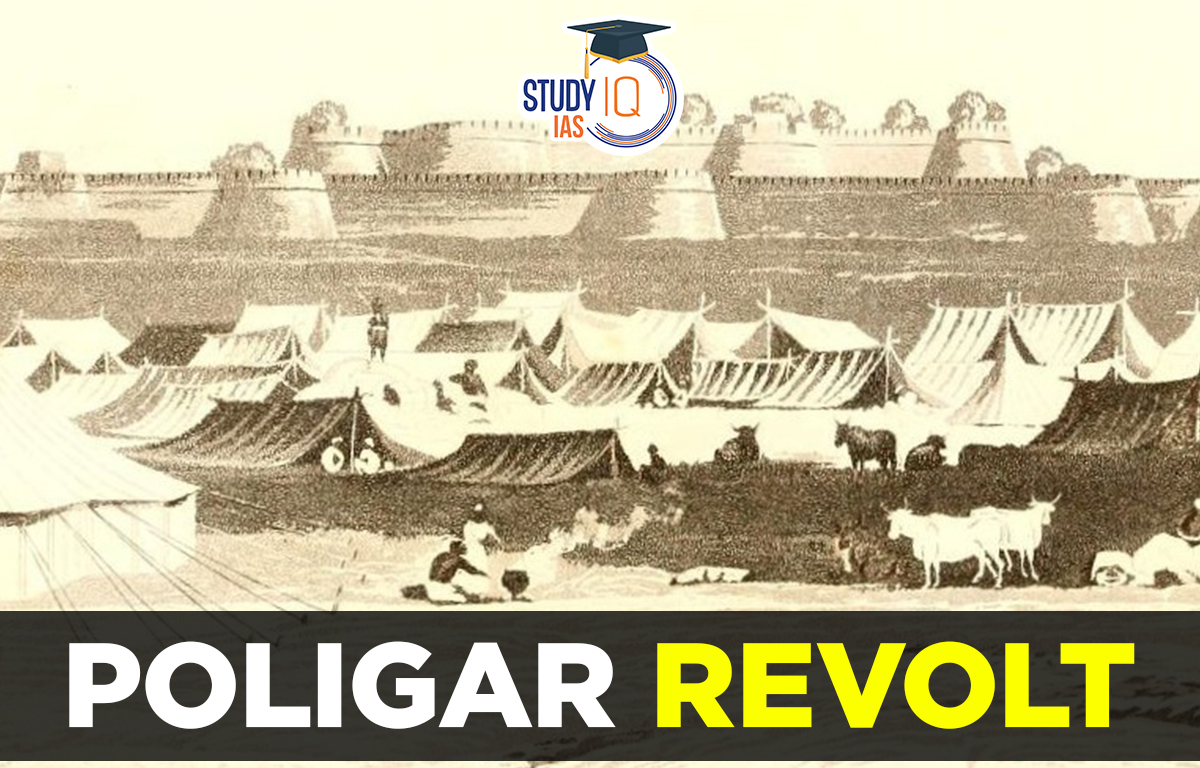Table of Contents
Poligars Revolt
Read all about Polighar Revolt. South Indian warriors called themselves the Poligars. Between 1795 and 1805, they resisted the British forcefully. Tinneveli, Ramanathapuram, Sivaganga, Sivagiri, Madurai, and North Arcot were the principal epicenters of these violent disturbances. For those students preparing for the UPSC/IAS Examination, this article includes all the information related to the Poligars Revolt.
Read More: Chuar Uprising
Poligars Revolt History
The Nayankara system, which was popular in the Vijayanagar administration, gave rise to the Poligars. The Rajputs of North India and the Poligars of South India were quite identical. They were the feudal lords who were granted land in return for their military services and designated as military chiefs. As they frequently acted as sovereigns and even went as far as to collect taxes from the populace, their sway and power expanded beyond the boundaries of the norm.
The issue started in 1781 when the Nawab of Arcot granted the British East India Company authority over Tirunelveli and the Carnatic Provinces. The government of the Company tried to exert control over the Poligars in order to increase its own revenue streams. The Poligars, who saw themselves as independent sovereign authorities within their various territories, were miffed by this arrangement.
Read More: Ramosi Uprising
Poligars Revolt Leaders
The Polygars were led by Kattabomma Nayak (also called Veerapandi Kattabomman) who was in charge of Panchalankurichi Palayam.
Read More: Kuka Movement
Poligars Revolt First Phase
In September 1799, in what is now known as the Tirunelveli area, the First Poligar Rebellion, also known as the First Poligars Revolt, began (in modern Tamil Nadu). Kattabomman Nayak (Veerapandi Kattabomman), in command of Panchalankurichi, served as the leader of this uprising. He declined to submit to British suzerainty and pay taxes to them.
The British and Kattabomman had a quick conference in 1799 to discuss unpaid taxes. However, the meeting concluded in a bloody clash in which Kattabomman killed the British Forces Commander. The Poligars openly rebelled after Kattabomman’s head was placed on a price list.
The Company’s forces eventually succeeded in defeating Kattabomman after a string of battles in the Panchalankurichi fort with the help of additional reinforcements from Tiruchirapalli. Kattabomman, however, escaped into the Pudukottai woods. Ettappan, the King of Pudukottai, assisted the British in capturing him by making a secret deal with them. The public hanging of Kattabomman served as a caution to other Poligars.
A close friend of Kattaboman’s, Subramania Pillai, was also publicly hanged. Another rebel commander, Soundra Pandian, was brutally murdered by the British. Oamaithurai, Kattabomman’s sibling, was detained in the Palayamkottai prison as the army looted and destroyed the fort.
Read More: Munda Rebellion
Poligars Revolt Second Phase
Even though the Brits put an end to the First Poligar War in 1799, a revolt erupted once more in 1800–1901. More bloodshed occurred during the Second Poligar War than the First. The Poligars held in the Palayamkottai fort managed to flee in February 1801, sparking the start of the second uprising. Many forts were taken over by the rebels, who were commanded by Oomaithurai (Kattabomman’s brother), who also managed to conquer Tuticorin. The British barracks in Coimbatore were attacked by a band of Poligar armies.
Oomaithurai joined forces with Maruthu Pandian to fight the East India Company in a broad coalition. Maruthu Pandian of Sivaganga, Dheeran Chinnamalai of Kongu Nadu, Gopala Nayak of Dindigul, Krishnappa Nayak and Dhoondaji of Mysore, Pazhassi Raja Kerala Varma of Malabar, and others participated in this South Indian confederacy against the Company.
After a protracted, costly campaign, the British forces eventually prevailed in quelling the Poligar rebellion. They received quick reinforcements from Malabar. The Panchalankurichi Fort was besieged by Company troops under the command of Lt. Colonel Agnew, and it was finally taken in May 1801 after a protracted siege and artillery barrage.
After the Panchalankurichi Fort was destroyed, Oomaithurai fled to Sivaganga and joined the Maruthu siblings at their fort in the jungle at Kalayar Kovil. Thereafter, Kalayar Kovil was pursued by British forces, who finally captured him in October 1801. On November 16, 1801, the Maruthu siblings and Oomaithuri were hanged in the Sivaganga district at Tiruppathur.
Read More: Santhal Rebellion
Poligars Revolt End Result
In July 1801, the Nawab of Arcot and the British inked the Carnatic Treaty. According to the terms of the Carnatic Treaty, the Nawab gave the East India Company exclusive control over the civil and military governance of all the Carnatic territories and dependencies for all time. After more than two centuries of prosperity, the Poligar regime abruptly came to an end. In its stead, the British established the Zamindari community.
The chieftains’ power was eliminated as a consequence of the Poligar rebellion’s suppression in 1799 and 1800–1801. The Poligars of North Arcot and Yedaragunta came up in revolt against the Company’s rule between 1803 and 1805. But the Brits had also put down these uprisings.
Read More: Khond Uprisings
Poligar Revolt UPSC
The Poligar Rebellion was the last glimmer of resistance by the Tamil people against the region’s inevitable descent into colonialism’s ignominy. The hamlet of Panjalamkurichi is adorned by a memorial centre for Kattabomman. The first great Poligar, Puli Tevan, had his headquarters in Tirunelveli, which is now venerated as a historic site. Read all about Poligar Revolt for UPSC Exam preparation.
Read More: Bhil Revolt


 Jallianwala Bagh Massacre, Date, History...
Jallianwala Bagh Massacre, Date, History...
 Important Lakes of India, State wise and...
Important Lakes of India, State wise and...
 Buddhism History, Origin, Sect, Councils...
Buddhism History, Origin, Sect, Councils...





















